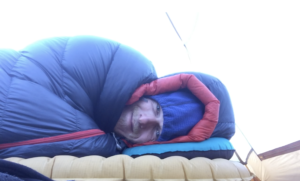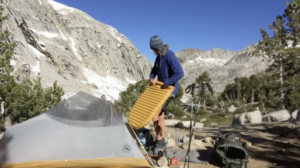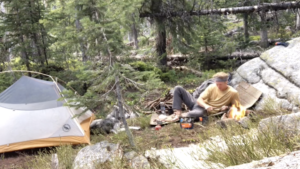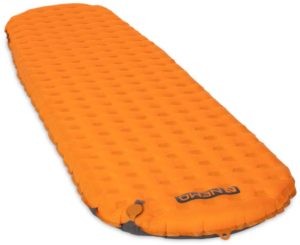
How do you like to spend your time outdoors? Some may say they like to rough it, and some may like to find comfort when possible. Well, that’s the beauty about being outdoors. You get to decide how you want to spend your time.
There are a few different ways we can seek comfort in the backcountry, and that is by choosing the right gear to supplement our personal style of backpacking and camping. Today we are going to talk about sleeping pads. I’m going to break it down for you in detail that will hopefully make it easier for you to figure out the perfect pad for you and your style of backpacking.
Huge Spring Sale on gear. Check out the link below! (Free Shipping over $40 + no sales tax!)
USOUTDOOR.com Sale! Save up to 70% off Outdoor Gear & Apparel
What’s Important to You in Your Sleeping Pad?
Weight– When backpacking, the majority of the weight in your pack is due to “the big four” (backpack, tent, sleeping bag, & sleeping pad). So this will be a chance for you to save some weight. Lighter packs make the day more enjoyable and your shoulders will thank you for it.
Warmth– Your sleeping pad will help keep you warm at night when the temperature drops. The R-value of a sleeping pad measures how well it will insulate your body from the cold ground. The higher the R-value, the warmer the pad will be. In general, sleeping pads with R-values of 0-2 will only be good for warm weather trips. R-values of 2-4 are good for most 3-season backpacking conditions. R-values of 4-6 are good when the temperature drops around or below freezing. You’ll likely want a pad with 5+ R-value (or you can add a foam pad under your air pad) if you’re a cold sleeper or if you’re winter backpacking and you’ll be sleeping on snow. It’s also important to note that, just like with sleeping bags, this is not an exact science.
Price– When it comes to price, it’s like anything else really. The higher the price, you’ll be looking at better quality. But as I mentioned earlier, we all have different needs and preferences. You can get a decent foam pad for $20-$50 or you could go for a higher quality inflatable pad closer to $200. You don’t have to spend a ton of money to get a good sleeping pad. With that being said, most people (including myself) will spend a bit more on a high quality pad that will last quite a few seasons.
Thickness– The thickness of your sleeping pad is crucial if you’re a side sleeper like myself. You’ll want it thick enough to be able to adjust the firmness of it without bottoming out through the night, but not too thick to where it feels like you’re sleeping on a pool float.

Sleeping Pad R-Values
The most reliable measure of insulation is R-value. I know I just touched on this, but let me reiterate. Beginning in 2020, a new Sleeping Pad R-Value Standard was adopted by the outdoor industry and most of the major sleeping pad manufacturers including Therm-a-Rest, NEMO, Sea-to-Summit, REI, and Big Agnes has retested and re-rated their sleeping bags using it. Klymit, notably, has not. This new standard benefits consumers because it makes it possible, for the first time, to compare sleeping bags by their R-values because they all use the same testing methodology.
R-Value measures how well an object resists the flow of heat from one side to another. The higher the R-value, the greater the resistance, and the better its insulating properties. When applied to sleeping pads, R-value measures a pad’s ability to keep your body heat from passing through the pad and into the ground. Sleeping pads aren’t designed to be warm, so much as to resist the transfer of heat. Highly insulated pads will usually feel warmer because they keep your body heat close.
For three-season backpacking and camping, an R-value of 2, or higher, is recommended. For winter backpacking and camping, an R-value of 5, or higher, is recommended. R-values are additive, so you can stack two pads to increase your warmth level. Women need higher R-values pads because they have lower body mass than men.

| Make / Model | Type | R-Value | Weight | |
|---|---|---|---|---|
| 1. Therm-a-Rest NeoAir XLite | Air | 4.2 | 12 oz | |
| 2. Therm-a-Rest NeoAir XTherm | Air | 6.9 | 15 oz | |
| 3. NEMO Tensor Insulated | Air | 3.5 | 15 oz | |
| 4. Therm-a-Rest Z Lite Sol | Foam | 2 | 14 oz | |
| 5. Sea-to-Summit Ether Light XT Insulated | Air | 3.2 | 16.3 oz | |
| 6. NEMO Tensor Alpine UL | Air | 4.8 | 17 oz | |
| 7. NEMO Switchback | Foam | 2 | 14.5 oz | |
| Air | 3.1 | 16.9 oz | ||
| 9. Big Agnes Q Core SLX | Air | 3.2 | 18 oz | |
| 10. Klymit Static V2 | Air | Low | 16.3 oz |
10 Best Sleeping Pads of 2020
Click the links below for the best prices!
1. Therm-a-Rest NeoAir XLite
The NeoAir XLite is the most popular inflatable sleeping pad sold today and for good reason. It packs up small and flat, taking up little room in a backpack. The XLite is 2.5 inches thick, providing plenty of comfort for side sleepers and back sleepers, with an R-value of 4.2 making it one of the best 3-season pads available. The XLite is available in a variety of widths and lengths, with the 72″ x 20″ regular size weighing in at just 12 oz. The XLite also comes with an inflation sack that can be used as a stuff sack. I chose to carry this sleeping pad on most of my thru-hike on the Pacific Crest Trail and I have no major complaints.
2. Therm-a-Rest NeoAir XTherm
The NeoAir XTherm is nearly identical to the NeoAir XLite but has more insulation and a tougher cover fabric for greater dependability in cold weather and winter. It also packs up small and flat, taking up little room in a backpack, despite having more insulation. The R-Value of 6.9 will keep you warm down to 40 below zero F, while the inflatable 2.5 inch thick pad provides plenty of cushion for side sleepers. The NeoAir XTherm is available in a variety of widths and lengths with the 72″ x 20″ regular mummy size weighing in at just 15 oz. The XTherm also comes with an inflation sack that can be used as a stuff sack.
3. NEMO Tensor Insulated Air Pad
The NEMO Tensor Insulated Air Pad strikes an excellent balance between low weight and comfort. Three inches thick, it provides plenty of clearance for the bony hips of side sleepers, but rolls up flat and surprisingly small when deflated. While it contains internal reflective layers like Therm-a-Rest’s NeoAir pads, it’s noticeably quieter and not crinkly sounding. Weighing just 15 ounces in a size regular (72″ x 20″), the Tensor has an R-value of 3.5, making it suitable for 3-season use. The Tensor Insulated pad is available in a wide range of lengths and widths, including a 9 oz short 48″ mummy which is ideal for ultralight backpacking. An inflation sack is included.
4. Therm-a-Rest Z Lite Sol Foam Pad
The Therm-a-Rest Z Lite Sol is an ultralight, inexpensive, and virtually indestructible foam sleeping pad, making it a favorite among ultralight backpacking fanatics and parents alike. Made with closed-cell foam, it folds up into accordion-like sections making it easy to carry and attach to the outside of a backpack. One side has an aluminized reflective coating which radiates your body heat back at you. With an R-Value of 2.0, the Z Lite Sol is a good warm weather sleeping pad. A size regular (72″ x 20″) weighs 14 oz, but it’s also available in multiple sizes. You can also trim a foam Z Lite Sol with scissors to shave off gear weight.
5. Sea-to-Summit Ether Light XT Insulated Pad
The Sea To Summit Ether Light XT Insulated Sleeping Pad has extra thick 4″ air sprung cells providing excellent comfort for side and back sleepers. ThermoLite synthetic insulation and a platinum liner reflect warmth back to you to minimize radiant heat loss. A flat valve makes it quick to inflate and deflate, and a combination stuff sack/air pump is included for ease of use. The Ether Light has an R-Value of 3.2, making it suitable for three-season use, while a size regular (72″ x 20″) weighs in at 15 oz. Multiple sizes are available.
6. NEMO Tensor Alpine Air Pad
 The NEMO Tensor Alpine is a four-season insulated sleeping pad that’s lightweight enough that it can be used year-round. With an R-value of 4.8, the Tensor Alpine is 4 inches thick and insulated with 3 layers of aluminum film much like Therm-a-Rest’s NeoAir pads but far quieter without any crinkly sounds to disturb your tent partner. A low profile flat valve provides rapid inflation, deflation, and micro-adjustments so you can fine-tune the inflation firmness. Weighing just 17 oz, the Tensor Alpine includes an inflation sack for rapid deployment.
The NEMO Tensor Alpine is a four-season insulated sleeping pad that’s lightweight enough that it can be used year-round. With an R-value of 4.8, the Tensor Alpine is 4 inches thick and insulated with 3 layers of aluminum film much like Therm-a-Rest’s NeoAir pads but far quieter without any crinkly sounds to disturb your tent partner. A low profile flat valve provides rapid inflation, deflation, and micro-adjustments so you can fine-tune the inflation firmness. Weighing just 17 oz, the Tensor Alpine includes an inflation sack for rapid deployment.
7. NEMO Switchback Foam Pad
The NEMO Switchback is folding accordion-shaped closed-cell foam pad with a reflective coating, like the Therm-a-Rest Z Lite Sol. The only real difference between the two is that the Switchback folds up slightly smaller when folded up. A size regular (72″ x 20″) weighs 14.5 oz, and has an R-value of 2. Like the Z Lite Sol, you can cut a Switchback up to save gear weight or reshape it for a specific purpose. Price Range: $40-$50.
8. Sea-to-Summit Ultralight Insulated Pad
The Sea To Summit Ultralight Insulated Sleeping Pad has 2″ thick air-sprung cells that adapt to a sleeper’s curves like the mattress of their bed at home, providing excellent comfort for side and back sleepers. Flat valves make it quick to inflate and deflate, and a combination stuff/air pump is included for ease of use. The Ultralight has an R-Value of 3.1, making it suitable for three-season use, while a size regular (72″ 20″) weighs in at 16.9 oz. Multiple sizes are also available.
9. Big Agnes Insulated Q-Core SLX Sleeping Pad
The Big Agnes Insulated Q Core SLX is a super comfy, lightweight inflatable sleeping pad, that’s 3.5 inches thick with a concave effect of 4.25 inch side baffles to keep you centered on the pad. With an R-value of 3.2, the Q-Core SLX is covered with a luxurious quilted top with flat valves for increased durability and rapid deflation. Insulated with Primaloft Silver, the pad is very quiet compared to pads insulated with reflective foil and includes an inflation sack for rapid inflation. A regular-sized (72″ x 20″) Insulated Q Core SLX weighs 18 oz, but the pad is also available in a very wide variety of lengths and widths.
10. Klymit Static V2
The Klymit Static V and Static V2 are the best budget air pads on the market. They’re built with thicker fabrics than most lightweight pads and are also slightly wider than the standard pad size. The V-shaped air tubes on this pad are comfortable, but the large spaces between air chambers mean you can easily bottom out while shifting around. The biggest downside with the Static V & V2 is their low R-value, which makes them best for summer trips only. That said, Klymit makes several variations of this pad in insulated versions, including the Insulated Static V, Insulated Static V Lite, and the Insulated V Ultralite SL.
Was This Helpful?
I hope you found this review helpful. I do my best to keep it short and sweet by cutting out all the unnecessary fluff, but still try to break it down as much as possible to help inform the reader. The goal is to help narrow down your search so you can find all of the information you need in one place. If you have any suggestions or just want some more information on a particular topic, please drop me a line in the comment section below and I’ll get to work! Let me bring the information to you!
*Editor’s note: Help support this site by making your next gear purchase through one of the links above. Click a link, buy what you need, and the seller will contribute a portion of the purchase price to support TheEpicReviews unsponsored gear reviews, articles, and hiking guides.
If you enjoyed this article, you may also like:
- 10 Best Backpacking Water Filters of 2020
- Best Backpacking Stoves of 2020
- Best Portable Chargers and Power Banks of 2020









